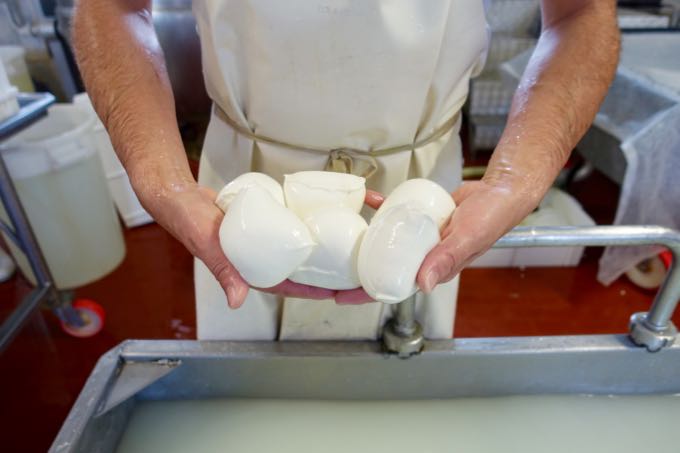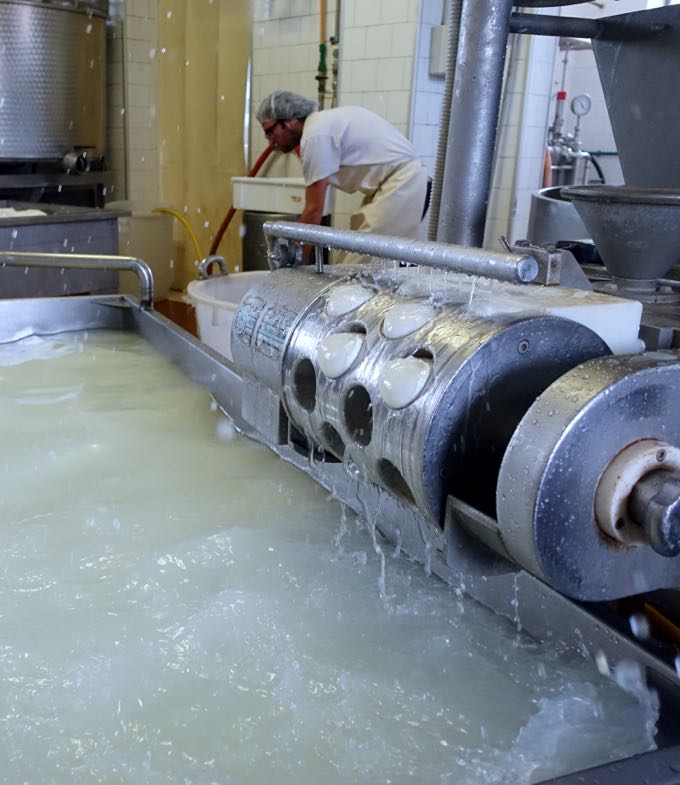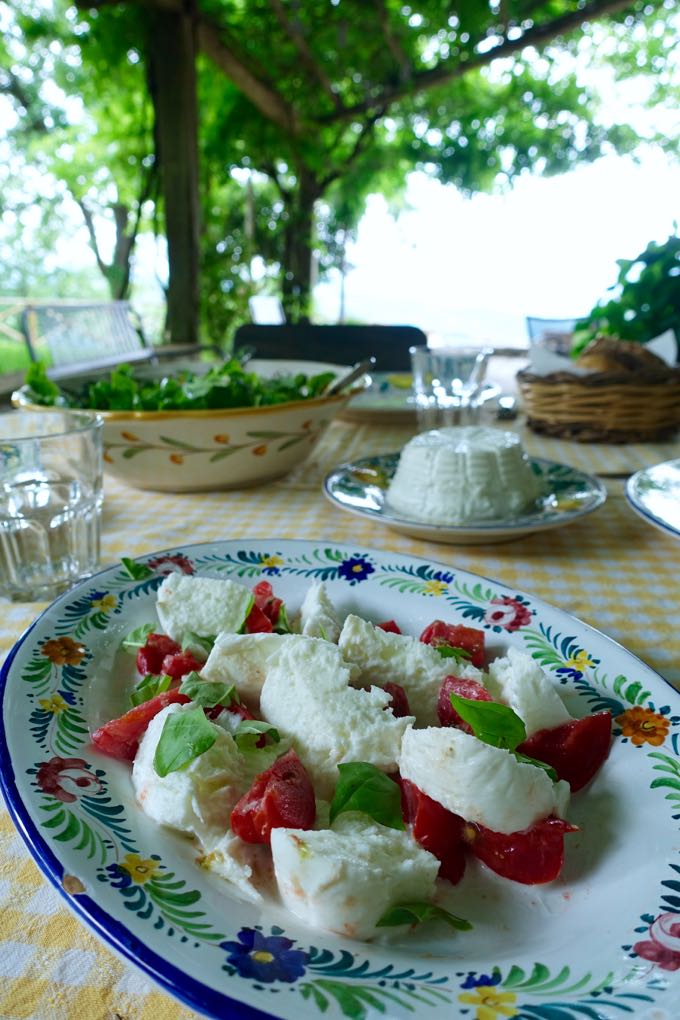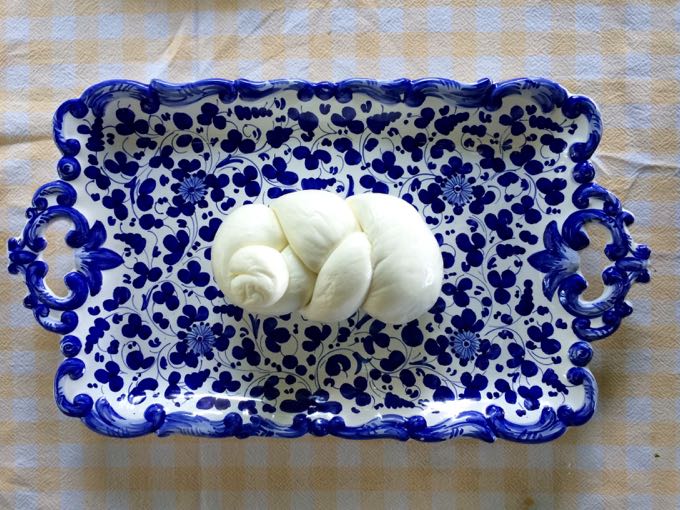
In my last newsletter* I mentioned that this year I was going to try to visit more people making food. I’m not talking about cooking. But visiting the artisans who are actually making the products that I use on a daily basis. One of the first visits on my ‘to do’ list was perhaps the one closest to my house. (Umbria, not Rome). I’ve been buying mozzarella and cheese from Caseificio Montecristo for about 20 years now. And although I’ve featured their wonderful cheeses many times on this blog, I’d never been behind the scenes to see the actual cheese being made. I guess I have the same excuse as New Yorkers never going to the visit the Empire State Building or Romans not going to the Colosseum. It was just there, and I’d been taking it for granted all these years.
When I first started visiting Caseificio Montecristo the store was located in the middle of a farm, with strange hours and barely any cheese for sale at any given time. I remember waking up early, phoning the store and asking if they could pretty please set aside some mozzarella and ricotta for me? Later that morning I would load Emma and Sophie into the car and we would make our mozzarella run. The best part for them was the chance to wave at the cows as we parked next to the stalls. The best part for me were, of course, the pristine white globes.
These days the Caseificio has changed a bit. They opened a very fancy store just down the road, in a new shopping center beneath the local motel. It may not be as picturesque (no cows) but it offered them a chance to truly expand their cheese making, including now at least 20 goat, cow and sheep milk cheeses that are extraordinary.
While I certainly enjoy these cheeses, it’s the mozzarella we still make a daily run for. Made from cow milk, not buffalo, it’s just about perfect. We basically live on that, and tomatoes, all summer long.
So a couple of weeks ago Sophie and I decided to make a visit to see how the mozzarella was made. It was really interesting, since I’d seen mozzarella being made in the past, but always by hand. Montecristo uses a small artisinal machine to make theirs, which is why they have been able to increase their production. Also, I found that one of the reasons I like their mozzarella so much may be due to the fact that they add salt to the curds as they make it, rather than salting the brine afterwards as is more common.
And if you’re curious how the mozzarella is made, don’t worry: I made a video.



*What?! You’re not signed up for my monthly newsletter yet? What are you waiting for? Just click here, and sign up.
Caseificio Montecristo
Via Campette (Complesso Europalace)
Todi , Pian di Porto
Tel: 075.898.7309
Open Monday-Saturday (closed at lunch time)
Located just off the Todi-Orvieto Exit on the E45. You’ll see the sign for the Europalace Hotel.
For more information on dining in Umbria and Italy download my app, EAT ITALY. EAT ITALY is a free app, and contains guides to Venice, Milan, Rome, Florence, Torino and Umbria (and an ever expanding list of regions and cities) available as in-app purchases for both iPhone and iPad.
Thanks for sharing this fantastic video, Elizabeth. It was fascinating to see how mozzarella is made. I’ve always seen it made by hand, but never by a specialized machine. How lucky you were to be able to get a behind the scenes tour!
Glad you liked it! The machine was new for me too, by the way.
Fascinating! However it needs a disclaimer in case you watch this before dinner. I’m having some serious cravings right now..
Loved watching the video!! And to think my hubby and I were in Todi and didn’t know about the cheese factory and the store 🙁 We loved Todi!! Now we have several more reasons to return. Buona giornata!
We really enjoy knowing how our favorite products are created, thank you, Elizabeth. And thank you to Domenico for his insights in the NY Times yesterday. Whether food or politics, it always fascinating to get a broader perspective from the folks who know.
Wonderful and fascinating video! Thanks Elizabeth Minchilli!
If this isn’t food porn I don’t know what is. Can you make one on burrata? But wait a week until I recover.
This is fascinating Elizabeth. I always wonder when I watch a process like this who was the person who originally thought of it. Anyway, they are a genius and we’ll be sure to visit Caseificno Montecristo if we are in the area.
We love this place too! How did I not know that you lived in Umbria?
Ok, now I’m really hungry. I’ll have to go by and see how they compare to Caseificio Ferretti in Ponte San Giovanni. Thanks for the heads up.
Love this. Some years back we were in Calabria, I believe, and we happened upon a road full of mozzarella shops! Turned out to be Buffalo Mozzarella, smaller balls of cheese. It was heavenly! We bought a 1/2 of kilo or so for our trip north! Will make a note for our next trip.
Wonderful! We will be in Bevagna in October and will definitely make a field trip.
So cool Elizabeth! I learned a lot and I love the knot and braid shapes. Definitely on my short list for my next visit to Todi.
Love it and all your videos + the music you choose!
The video you posted was very informative. The cheese doesn’t look like much when its being made, but the end result is so delicious. Thanks for sharing this post with us.
On our recent south-Italy tour, we were lucky to be able to visit Tenuta Vannulo, south of Salerno.
After the tour of the facility, they served the group a variety of buffala products for lunch.
Vannulo is great fun, and delicious!! Love the gelato!
Good article Elizabeth, but I think you need to go in Naples/Aversa/Battipaglia to try the real mozzarella di bufala 😉
Thanks! Yes, mozzarella di bufala is made in the region of Campania. But this is about mozzarella made from cow’s milk. They are two very different things.
Please help me……why my curd always become ricotta?
First i want ask….when we add citric acid…..is it need to check the ph?is it must get ph 5.2?
When i got the ph 5.2 with citric acid….all my milk become crumble……
But if i use juat little citric acid…..i am also can not get mozzarella….
When i followed like this to…..
5 liter milk with 8 gram citric acid
I am also can not get mozzarella….
Please help me
I am frustation
I had try 10 times…and all is failed
I’m sorry you’re having difficulties. Making mozzarella is a bit of an art. I know a lot depends on the milk you start out with, and that affects quantities, timings and temperature. I’m not an expert by any means, and so can’t really help you.